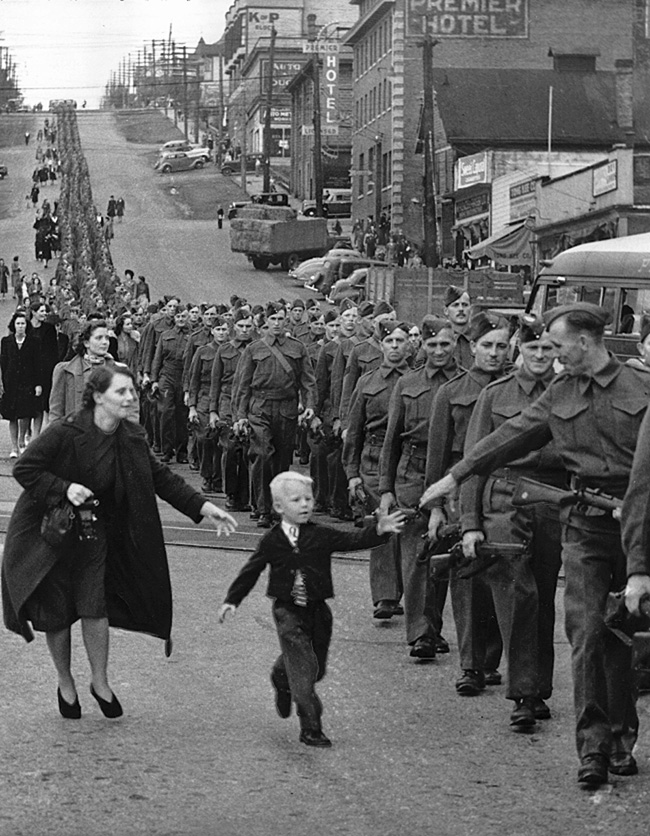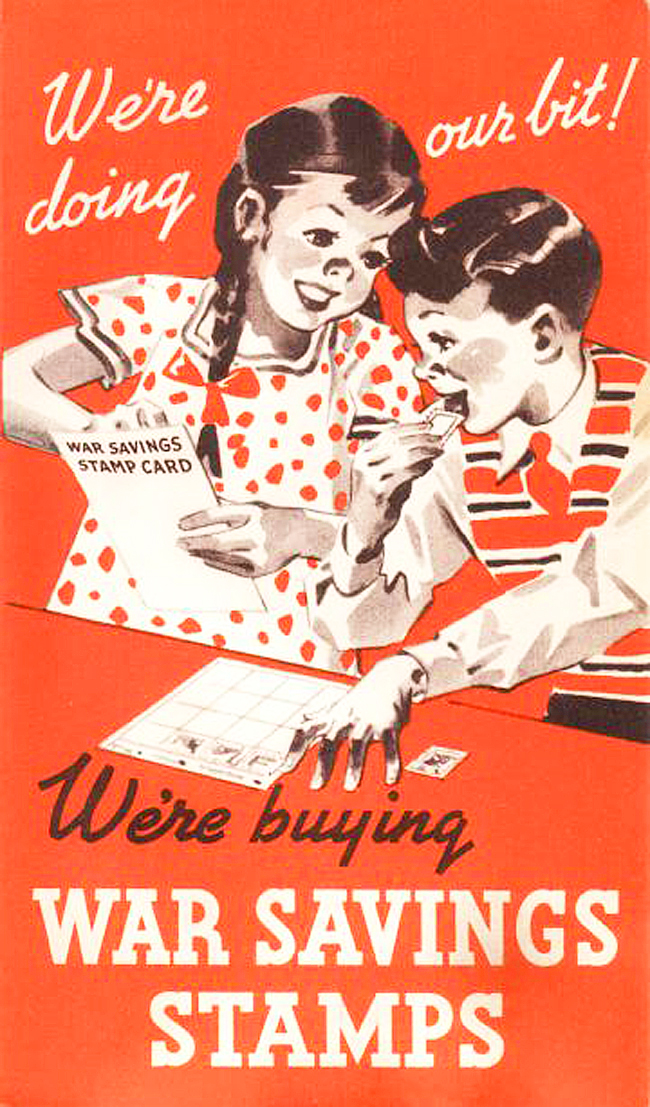Life on the Home Front in wartime wasn’t just hard, it was crushing. While gathering on Remembrance Day to honour the men who fought for freedom, we tend to overlook the painful sacrifices made by the women and children left behind.

* * * * *
Home Front: Saying Goodbye
The most harrowing aspect of war was saying goodbye to the men, never knowing when and if they would be coming home.
“Wait for me, Daddy” is an iconic photograph taken in 1940 by newspaper photographer Claude Dettloff. It captured the touching scene of a five-year-old boy named Warren Bernard running after his father, Private Jack Bernard, as he marches off to war in New Westminster, British Columbia.
The good news is that Warren’s father DID come home, and he saw his son for the first time in five years. The boy looks happy but must be feeling a little apprehensive to be hugged by this man, who is by now almost a stranger!

* * * * *
Home Front: Mail Was Vital
In the days before telephone or email, the only connection between the Home Front and the men overseas was by post. Families wrote literally tons of letters and sent millions of parcels overseas.
This Star Weekly cover tells the story: kids preparing a parcel for Daddy, who might have missed as many as six Christmases. To see my complete collection of Star Weekly covers: Star Weekly At War.

This photo from Library and Archives Canada shows some of those dedicated postal workers in Ottawa. There were no computers then — every piece of mail had to be read and sorted by hand. It was tedious, back-breaking labour.

The Royal Canadian Air Force created a special squadron to handle the enormous volume of mail. Their mission was to keep up morale on both sides of the ocean.
Members of ‘The Morale Squadron,” as they called themselves, understood that mail was a priceless commodity and a vitally important weapon in the battle for victory.
They flew the mail to Scotland, where it was sent by train to London, then sorted and flown to bases all over the Western world.
To read more about this: Morale Squadron Made Mail Their Mission.

* * * * *
Home Front: Working Women
Almost one million Canadian women joined the work force during the Second World War. They manufactured tanks, trucks and aircraft, PLUS they filled all the jobs that the men had left vacant, many of them dreary and exhausting.
They were the single working mothers of today, responsible for earning a living, managing a household, and raising their children.
Rosie the Riveter, the bomb girl with the red kerchief and the bulging biceps, is an iconic Home Front image. But Canada led the way with our own glamourpuss: Ronnie, the Bren Gun Girl. She was one of 800 Canadian women who worked in the Inglis factory in Toronto, manufacturing light machine guns known as Bren guns.

But the women in factories weren’t all glamorous, as this Star Weekly magazine cover shows. To read more about this: Bombshells and Bomb Girls.

* * * * *
Home Front: Working Kids
Kids grew up fast in those days. Canadian kids were keen to defeat the enemy, and their enthusiasm turned them into valuable assets. Schools, churches, and government harnessed all that youthful energy and put it to work.
Encouraged by their parents and teachers, plus incentives such as free passes to movies, kids collected tons of metal, paper, rubber, and grease. These materials were in short supply and were recycled into weapons and war machines. Some kids even donated their own toys for metal salvage drives.
These two boys in Montreal were photographed in April 1942, collecting rubber tires and boots to be recycled as part of Canada’s war effort.

The government even coerced kids into emptying their piggy banks. Children used their pocket money (and in those days, every nickel was hard-earned) to buy War Savings Stamps, which they stuck into special booklets for post-war redemption. A child could buy War Savings Stamps for 25 cents each, and after saving $4 worth of stamps, the child would receive a War Savings Certificate worth $5.
Of the $5.5 billion raised in Victory Loans, millions were contributed by children!

* * * * *
Home Front: Eating Less
For five long years, our food intake was rigidly controlled: one cup of sugar per person per week, one-quarter cup of butter, five ounces of meat, etc.
But there were few complaints on the Home Front. Not only were we shipping food to one million members of our own armed forces, but we were feeding the desperate British population, who would probably have starved otherwise.
To supplement their diets, Canadians hunted and fished and picked berries and plowed up their lawns to grow enormous Victory Gardens. Children helped, since even the youngest kids could tell the difference between a weed and a vegetable.
Mothers became extremely good at meal planning to keep their kids healthy. Kids didn’t eat a lot of sweets, nor did they expect any. Since Canada was unable to import food from other countries by sea, many of them grew up never having seen an orange or a banana.
This little tyke is presenting the storekeeper with his ration book, in which a record was kept of all food purchases. To read more about this: Rations and Recipes.

* * * * *
Home Front: Knitting
Knitting socks and scarves for the fighting men, who were often filthy and freezing, became a patriotic duty on the Home Front. Everyone knit, even cab drivers, hospital patients, and convicts. Schools and children’s organizations led the way, with knitting taught in many classrooms. In this photo from the Canadian War Museum, there is only one girl on the left; the rest are boys.
To read more about this: Knitting for Victory.

* * * * *
Home Front: Staying Home
Just like those for food, ration books were issued for fuel, and each time you filled up in Canada you had to fork over a number of your precious coupons.
And I do mean precious. Owners of non-essential vehicles were allowed just 120 gallons of gas a year. Bus and train travel wasn’t allowed unless you were on war work. Civilian ocean travel was banned. People walked, rode bicycles or horses. Holidays away from home were pretty much out of the question!
To read more about this: Saving Fuel for the War Effort.

* * * * *
Home Front: Playing War
It wasn’t possible to shield children from the terrible reality, since war infiltrated every aspect of their lives. Toys, games and even comic books revolved around war.
War was a common game played on the streets. Boys, with sticks for guns, pretended to be the uniformed men they saw everywhere. And they were encouraged by their families to be “just like Dad.”
You could even order miniature uniforms so kids could dress like soldiers.

However, there was no talk of losing. Hitler was a comical figure, easy to defeat.
To read more about this: Children on the Home Front.

* * * * *
Home Front: Grief and Loss
Forty-five thousand Canadian men died in the Second World War, and their next of kin was generally notified with the arrival of a stark telegram like this one.

This beautiful illustration by Andrew Loomis, “In Memory,” depicts a valiant widow and her children in church. She is wearing her dead husband’s posthumous Distinguished Service Cross, the second highest award presented by the American armed forces for valor.

* * * * *
Home Front: Home at Last
At war’s end, the survivors returned home. The repatriation of Canada’s armed forces, involving nearly seven per cent of its population, was perhaps the largest movement of people in Canadian history.
In this photo from Library and Archives Canada, relatives in Halifax, Nova Scotia, greet returning Canadian soldiers aboard a troopship.
To see more heartwarming homecoming photos: I’ll Be Home for Christmas.

* * * * *
My TV Interview
I discussed this very topic with Elizabeth Heinz, host of Coast Connections, a television program that will air on Vancouver Island during the month of November.
Click here to watch: Life on the Home Front.

* * * * *
Waiting for the Winner
Friends, last month I sponsored a draw of $100 for one lucky blog subscriber, to be spent at an independent bookstore of his or her choice. I made the draw (the random number was generated by a computer) on Sunday morning, November 12, and immediately emailed the winner. If you did not receive an email from me, you did not win. But if I don’t hear back from the winner in seven days, I will draw another name next Sunday.
Coming next month: a peek at my first trip to the Big Apple!
Affectionately, Elinor
